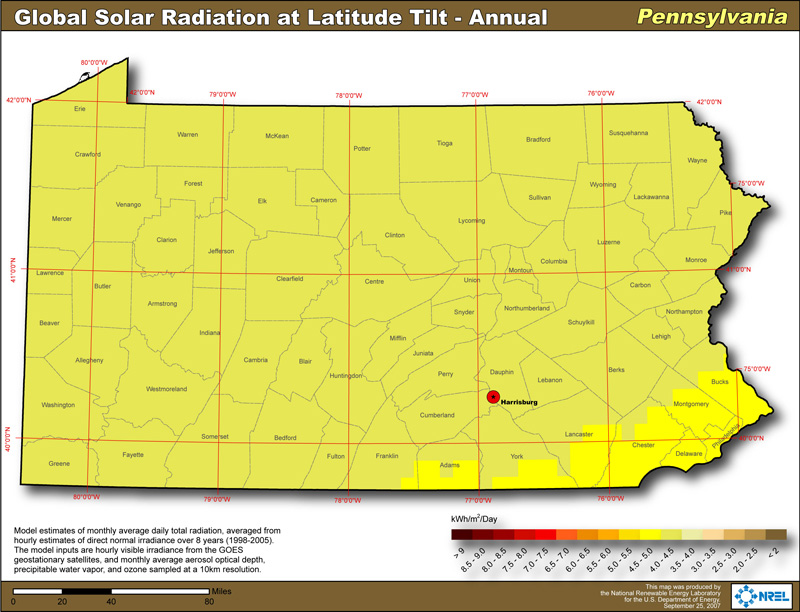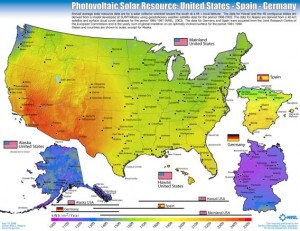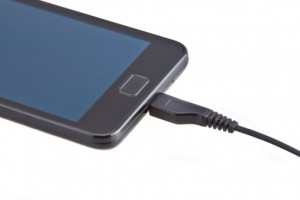Technical Analysis

The technology aspect of this project mainly focuses on the capabilities of the solar umbrella itself. It is relevant to explain how solar panels work in so far as they pertain to renewable energy. Solar panels consist of two layers separated by a junction. Electrons on the top layer move freely and a charge imbalance is intentionally created between the layers. Photons from the suns’ rays hit the layers and the electric field that forms across the junction causes electricity to flow. The circuit is closed by the electrons “wanting” to return to the upper layer to balance the charge discrepancy. Please visit this link for more detailed information on how solar panels work (How Solar Panels Work)
Since solar panels require sunlight to produce electricity, how suitable is Lafayette college for the implementation of solar technology?


Easton, Pennsylvania (PA) gets about 4.5-5kWH per meter squared of collected sunlight per day. “The kilowatt-hour (symbolized kWH) is a unit of energy equivalent to one watt (1 W) of power expended for one hour (1 H) of time” (Techtarget.com). In 2013, Pennsylvania installed 38MW worth of solar technology. This ranks Pennsylvania 14th in the country so far as energy production via solar technology is concerned (seiastate.org). Pennsylvania can be compared to Germany, a country that obtains 20% of its energy on any given day from solar technology (Plumer, 2014). PA is much better suited for the implementation of solar panels than is Germany, the world’s leading solar technology user as can be seen from figure 2. Germany only gets around 1000 kWH/meter squared of solar energy a year while PA gets around 1900 kWH/meter squared.
Three sites were selected as possible Power-Dok locations. Ideally, this location would be convenient for students as well as optimize sunlight capture for the solar panels. The usefulness of solar panels in these locations as it pertains to building shading and other factors was analyzed. The locations included the outdoor dining facilities at Farinon, Gilbert’s, and Simon’s. Based on the orientation of these locations in relationship to the daily movement of the sun it was decided that Farinon receives sunlight for the first half of the day, Simon’s for the whole day, and Gilbert’s for the whole day. Therefore, Simon’s and Gilbert’s were the two most attractive locations for Solar Power-Dok technology.

Furthermore, it was necessary to obtain detailed performance capabilities of the Solar Power-Dok technology. The Solar Power-Dok is capable of generating 600Wh, which is equivalent to the energy needed to power a refrigerator (Saltzman, 2012). Students would mainly use the 6 possible USB and standard outlets available on the Power Dok to charge phones and laptops. The typical iPhone needs 5.45Wh to charge and an average laptop requires 197Wh to charge (Helman, 2013). According to the head of Plant Operations at Lafayette, Bruce Ferretti, Lafayette consumed 26.4 million kWH of energy in 2013. The Power Dok will hardly put a dent into this massive energy usage, but, as has been explained in other sections, the purpose of this project is to raise student awareness in regards to sustainable solutions and not to make Lafayette a 100% solar-powered campus. The charging station produces a readout for students about how much energy is currently being generated by the solar panels. This feature is useful for helping students interact with the Power Dok and to quantify the difference its utilization makes. This technology also has a battery which stores excess energy for use at night or during a cloudy day. This battery must be replaced once every eight years. The Solar Power-Dok is “off the grid” so its usage can only detract from campus electricity usage. For more details on the specifications of the Solar Power Dok, please follow this link.

Other technical considerations were made apart from the solar energy components. The Solar Power-Dok unit consists of the solar umbrella, table, and bench. The portability of these parts, or lack thereof, was also important. As the product must be installed by EnerFusion in a permanent location, they can not be considered portable. If the school denies funding for this project, plan B is to pass it on to senior design projects. Engineers could design and build the actual solar panels, economics majors could perform cost analyses on the project, and Gov/Law and EGRS students could tackle social and policy topics. It could become an interdisciplinary project that brings engineering and the liberal arts together to benefit Lafayette College and raise awareness about the importance of sustainable solutions.
To view more about this project, please continue to the economic analysis.

Leave a Reply